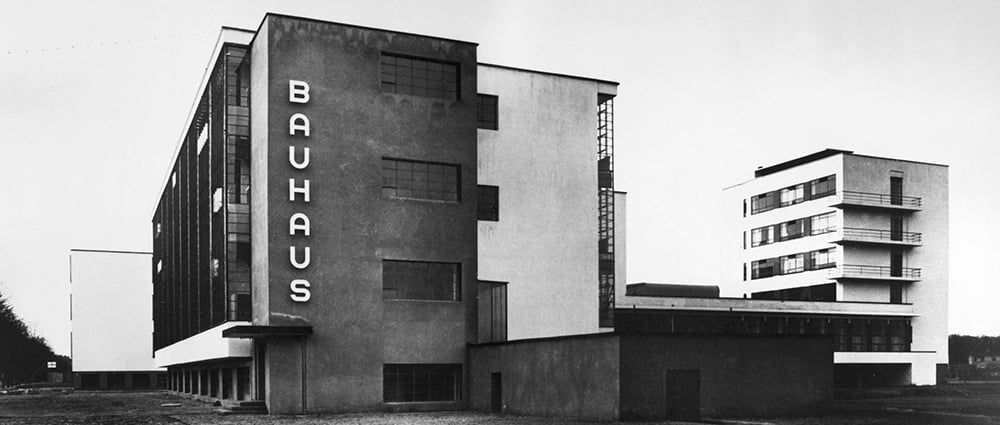
Celebrating 100 Years since the Birth of Bauhaus
The year 2019 marks the 100th anniversary of the Bauhaus, a revolutionary art school started by the German architect Walter Gropius which, despite the fact that it was short-lived (1919-1933), would greatly influence the development of modern art and design. The artists associated with the Bauhaus (such as Wassily Kandinsky, Paul Klee and Laszlo Moholy-Nagy) sought to completely redefine art, by uniting different artistic disciplines and focusing on craft and functionality. These ideals were translated into colourful geometric abstraction and stripped-back designs. However, the School’s reimagining of the world did not stop at art: the Bauhaus designed for a new, modern kind of person. Through rare photographs from our archive, we find out more about the community at the Bauhaus, and its vision for modern life.
The Bauhaus Community
“Together let us desire, conceive, and create the new structure of the future, which will embrace architecture and sculpture and painting in one unity and which will one day rise toward Heaven from the hands of a million workers like the crystal symbol of a new faith.”
Walter Gropius, Program of the State Bauhaus in Weimar (1919)
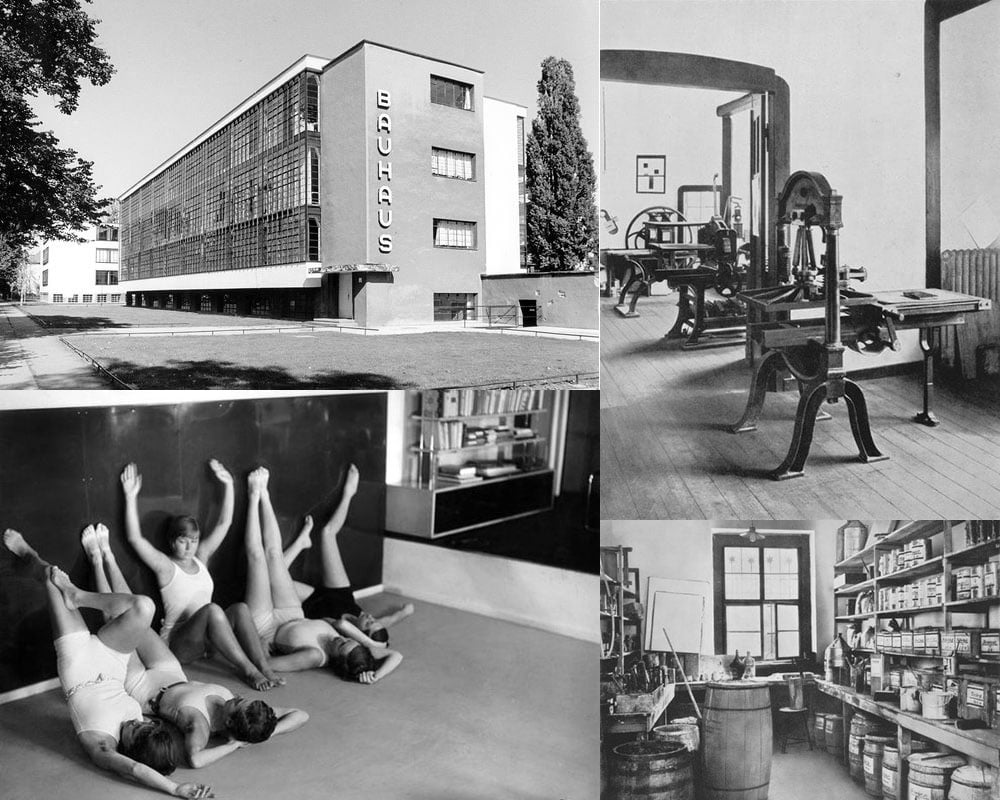
View of the Bauhaus Dessau, Germany, 1998 (b/w photo) / © SZ Photo / Manfred Vollmer; The Printing Works, from the Workshops of the Bauhaus, Weimar, 1923 (b/w photo) / Private Collection / The Stapleton Collection; Appartement Bauhaus / © SZ Photo / Scherl ;The Mural Studio Storeroom, from the Workshops of the Bauhaus, Weimar, 1923 (b/w photo) / Private Collection / The Stapleton Collection
Though you wouldn’t guess just by looking at the group’s ultra-modern artistic output, the Bauhaus’ ideals were firmly rooted in the past. Inspired by medieval guilds, artists worked and were educated in workshops like craftsmen. Furthermore, students and teachers at the Bauhaus lived and ate together, and attended communal sporting and recreational activities (such as the school’s renowned costume parties!). Being at the Bauhaus became an all-encompassing way of life.
Rethinking the Everyday
“The ultimate, if distant, aim of the Bauhaus is the unified work of art – the great structure – in which there is no distinction between monumental and decorative art.” Walter Gropius, Bauhaus Manifesto and Program, 1919
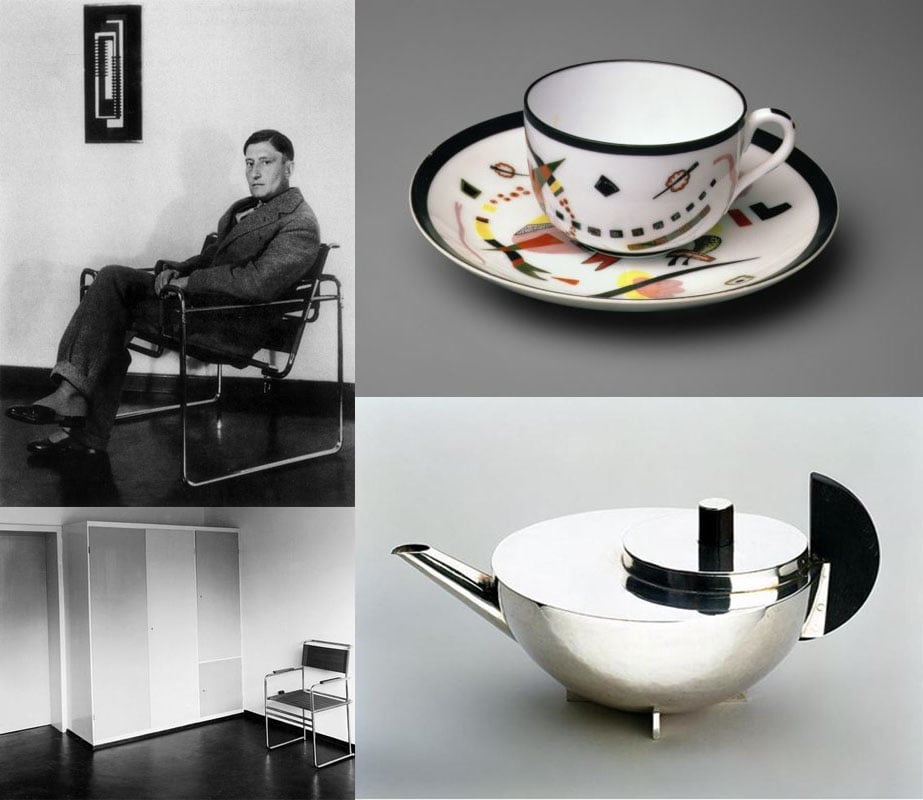
Josef Albers, 1928 (b/w photo), Umbo (1902-80); Cup and Saucer, 1923 (china), Wassily Kandinsky (1866-1944) / Private Collection; Interieur Bauhaus / © SZ Photo / Scherl; Tea Infuser and strainer, made by the Bauhaus Metal Workshop, Weimar, 1924 (silver with ebony), Marianne Brandt (1893-1983) / Private Collection / Photo © The Fine Art Society, London, UK
Central to Bauhaus ideas was the Gesamtkunstwerk (synthesis and use of all artistic disciplines), and in this line of thought the artists’ production wasn’t at all confined to the realm of fine art. Teaching workshops on subjects such as textiles and murals, the school turned its attention to the living environment, making functional buildings, spaces and objects for everyday use. Designers such as Marcel Breuer for example created minimalist, lightweight chairs (with the view that chairs would at some point disappear altogether and be replaced by air columns), and even Kandinsky experimented with ceramics.
Art for All
“Our guiding principle was that design is neither an intellectual nor a material affair, but simply an integral part of the stuff of life, necessary for everyone in a civilized society.”,
Walter Gropius
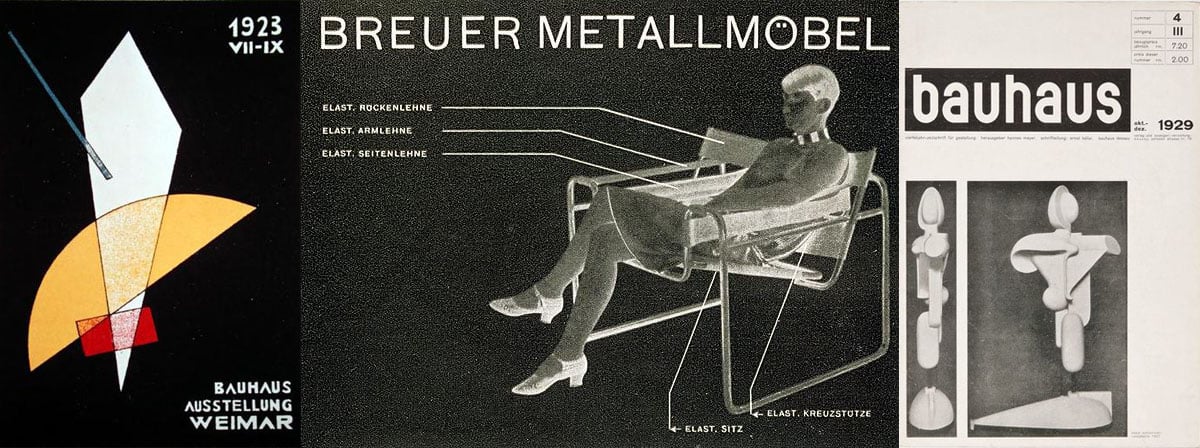
Poster for a Bauhaus exhibition in Weimar, Germany, 1923 (colour litho), Laszlo Moholy-Nagy (1895-1946) / Nationalgalerie, Berlin, Germany; Advertisement for the ‘Breuer Metallmobel’ Bauhaus style chair designed by Herbert Bayer (1900-85); Number 4, Volume 3 of the ‘Bauhaus’ magazine, 1929 (lithograph), German School, (20th century) / Private Collection / Photo © Christie’s Images
Part of Gropius’ idea had been to make art and design more democratic and accessible, and to combine original designs with potential for mass production and consumption. The Bauhaus reached beyond its own members, and started addressing a bigger audience. With typography workshops led by the likes of Laszlo Moholy-Nagy and Herbert Bayer, the Bauhaus developed a public image, distributed through a host of print media including posters and commercial advertising. The combinations of text and image, as well as an iconic sans-serif font, helped define a visual language that was above all aimed at clarity and understanding.
Rebuilding Man
“The intellectual bourgeois of the old Empire – tepid and unimaginative, mentally slow, arrogant, and incorrectly trained – has proven his incapacity to be the bearer of German culture. His benumbed world is now toppled, its spirit is overthrown, and is in the midst of being recast into a new mold.” Walter Gropius
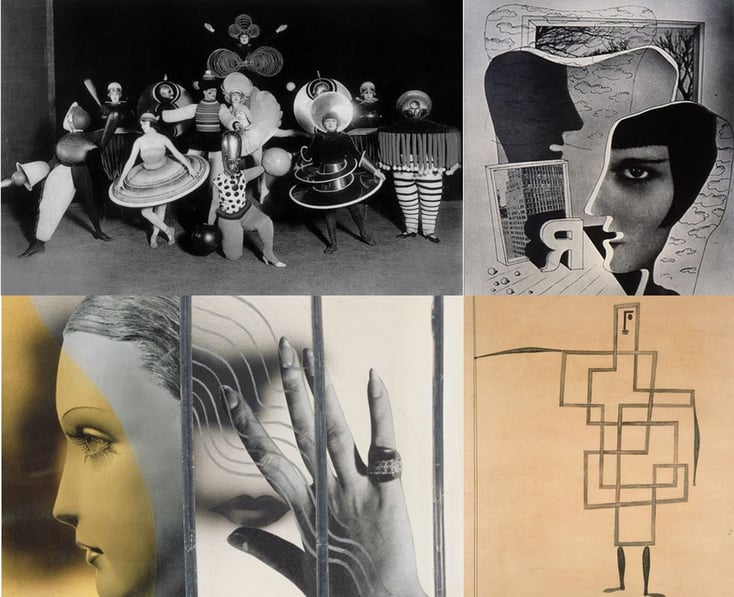
Costumes by Oskar Schlemmer (Bauhaus) for Ballet triadique, at Metropol theater in Berlin, photo by Ernst Schneider, 1926 / Photo © PVDE; ‘Profil en Face, 1929 (silverprint), Herbert Bayer (1900-85) / Private Collection; Design Project’, 1935 (photomontage, pencil, perspex & silver foil), Laszlo Moholy-Nagy (1895-1946) / Private Collection; Prince, 1930 (pen & ink and w/c on pink paper), Paul Klee (1879-1940) / Private Collection / Photo © Boltin Picture Library
When designing functional objects for modern people, the artists associated with the Bauhaus school also started to rethink who this modern person was. Some members of the school even rethought man’s appearance, from clothing through to the ways our bodies are put together. Especially the connection between man and industry is a theme that pops up throughout such artworks. One artist who continuously explored this connection and kept adjusting and augmenting the human form was Oskar Schlemmer, whose innovative (and slightly bizarre!) ballet costumes turned traditional theatre costume design on its head. Another example is the Dutch artist Theo van Doesburg’s costume at the 1922 Bauhaus Ball, which seems to be directly inspired by Dadaist Georg Grosz’ famous 1920 watercolour Republican Automatons. At the Bauhaus, art and life meet and merge. Sometimes, it is hard to tell them apart.
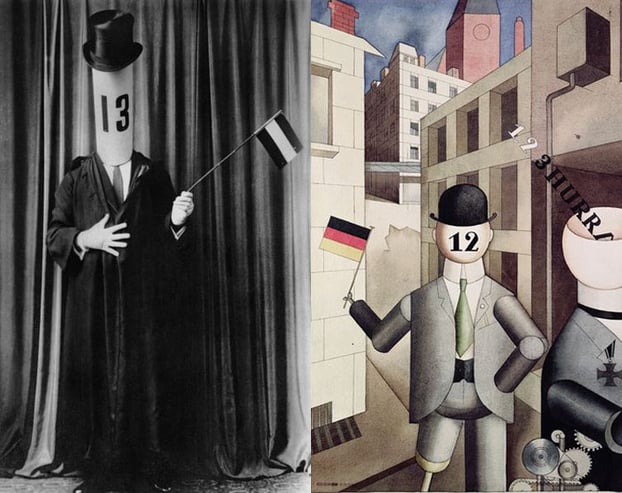
Theo van Doesburg (1883-1931), dutch painter, architect and theorician, here at Bauhaus ball in Berlin, 1922 / Photo © PVDE; Republikanische Automaten, 1920 (w/c on paper), George Grosz (1893-1959) / Museum of Modern Art, New York, USA
Find out more:
Explore Bauhaus Photography
Examine Bauhaus Fine Art
Enjoy Bauhaus Architecture
Like what you see? Get in touch with your local Bridgeman Images office for any image research or licensing queries:
North and South America: nysales@bridgemanimages.com
